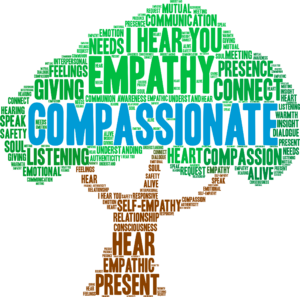Compassion & Empathy
May 12, 2023
To Inspire:

This year we’re sharing insights from some of the books we find inspirational and informative. Matt Palmer has been talking about “From Strength to Strength” by Arthur Brooks (If you missed his latest article, read it here.) This week, I (Michelle) am continuing to share from “Atlas of the Heart” by Brene Brown (you can read my first article about this book here).
Compassion and empathy. Which is most important when trying to connect with struggling people? And, importantly, connecting with people without taking on their issues as our own, which can become overwhelming.
There are differences between compassion and empathy, and there are different types of empathy that are important to understand. Calling on years of her own research as well as that of others, here are the definitions Brown uses:
Compassion is a daily practice of recognizing and accepting our shared humanity so that we treat ourselves and others with loving kindness, and we take action in the face of suffering.
Empathy, the most powerful tool of compassion, is an emotional skillset that allows us to understand what someone else is experiencing and to reflect back that understanding.
Compassion
One of the most interesting things when we think about this definition of compassion is that it includes action. It’s not just feeling a certain way, it’s doing. Compassion is not a practice of “I’m better than you” or “I can fix you” – it’s a practice based in shared humanity. It’s understanding that we all have struggles, and our experiences allow us to come along side someone who is struggling and show them we understand and are there to help.
In her book “The Places That Scare You,” the American Buddhist nun Pema Chodron writes about compassion:
When we practice generating compassion, we can expect to experience our fear of pain. Compassion practice is daring. Compassion is not a relationship between the healer and the wounded. It’s a relationship between equals. Only when we know our own darkness well can we be present with the darkness of others. Compassion becomes real when we recognize our shared humanity.
Empathy
One element of empathy is cognitive empathy – the ability to recognize and understand another person’s emotions – and it’s crucial for meaningful connection. In simple terms, cognitive empathy is understanding what someone is feeling, not feeling it for them. Brown says, “If someone is feeling lonely, empathy doesn’t require us to feel lonely too, only to reach back into our own experience with loneliness so we can understand and connect.”
We need to dispel the myth that empathy is “walking in someone else’s shoes.” Rather than walking in someone’s shoes, we need to learn how to listen to the story that person is telling about what it’s like in their shoes AND believe them even when it doesn’t match our experiences.
Empathy also means avoiding judgement. Just listen, don’t judge. And when thinking of compassion and empathy, avoid pity. Pity may seem like compassion or empathy, but instead of openness, pity says, “Oh, I feel sorry for that person.” Pity means seeing someone struggling as different than yourself. It sets up separation, a sense of remoteness. Choose connection through compassion instead.
Take a moment this weekend to think about compassion and empathy. How understanding these ideas can shape a kinder, more open approach to the world and enable us to truly connect with others and help those who may be struggling.

Written by Michelle O’Brien, Manager of Marketing & Communications